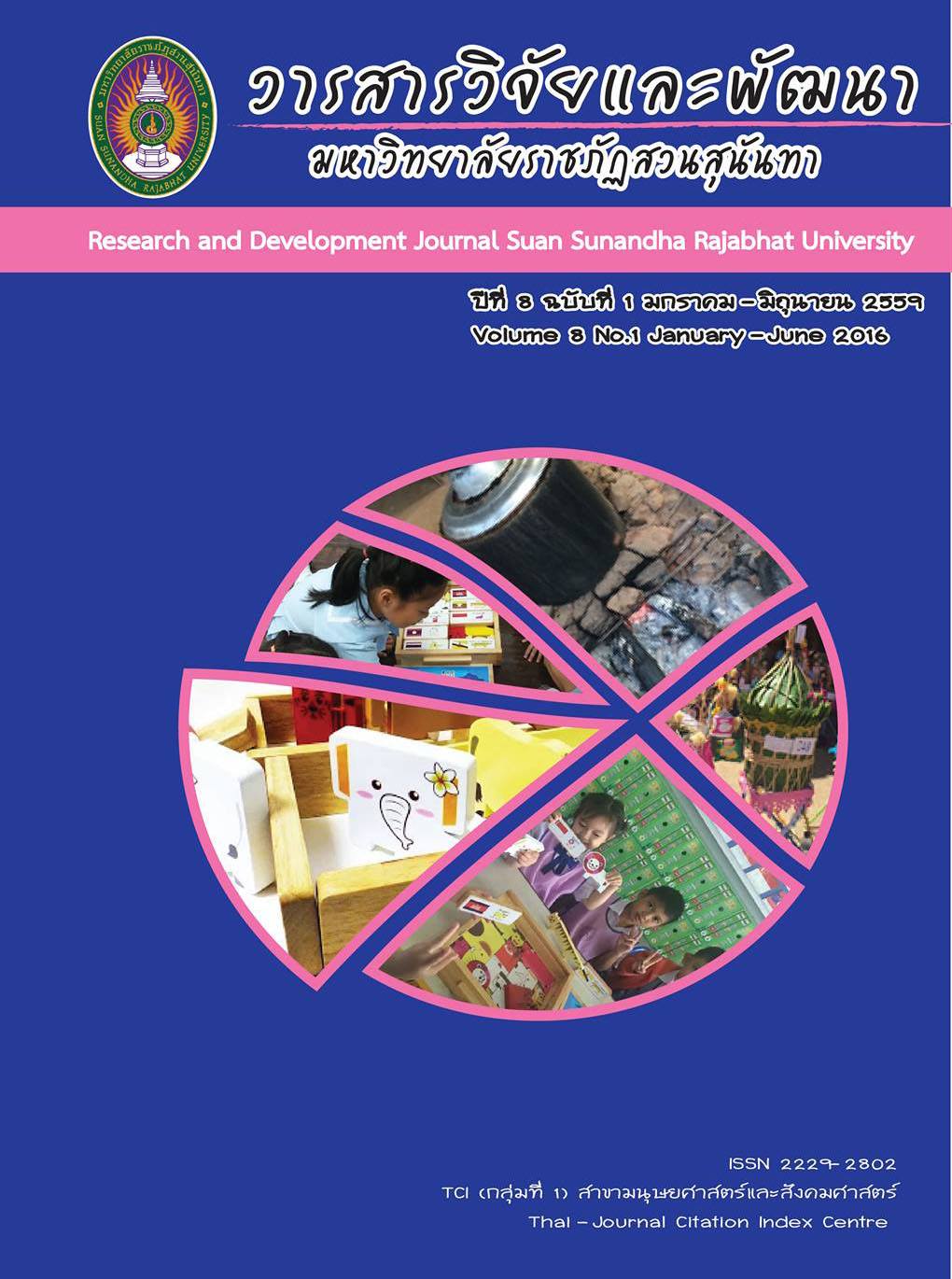การจัดการเรียนการสอนวิทยาศาสตร์เพื่อส่งเสริมทักษะความคิดสร้างสรรค์
DOI:
https://doi.org/10.53848/irdssru.v8i1.214811คำสำคัญ:
การจัดการเรียนการสอน, ทักษะ, ความคิดสร้างสรรค์, วิทยาศาสตร์บทคัดย่อ
ความคิดสร้างสรรค์ถือเป็นเป้าหมายการเรียนรู้ที่สำคัญอย่างหนึ่งของนักเรียนในศตวรรษที่ 21เนื่องจากเป็นยุคที่องค์กรต่าง ๆ ต้องอาศัยบุคลากรที่มีความคิดสร้างสรรค์ในการคิดค้นนวัตกรรม เพื่อ
เพิ่มศักยภาพในการแข่งขันทั้งทางด้านเศรษฐกิจและด้านเทคนิคขององค์กร วิชาวิทยาศาสตร์เป็นวิชาที่เหมาะสมสำหรับนำมาใช้ในการพัฒนาความคิดสร้างสรรค์ของนักเรียน เนื่องจากสอดคล้องกับธรรมชาติในการทำงานของนักวิทยาศาสตร์ที่ต้องอาศัยความคิดสร้างสรรค์และจินตนาการ เพื่อมองปรากฏการณ์ที่เกิดขึ้นจากมุมมองทางด้านทฤษฎีและการทดลองที่แตกต่างไปจากเดิม และนำไปสู่การค้นพบความเข้าใจใหม่ทางวิทยาศาสตร์ แนวทางการจัดการเรียนการสอนเพื่อส่งเสริมความคิดสร้างสรรค์สามารถทำได้โดยการสร้างสถานการณ์การเรียนรู้ที่มีลักษณะเป็นปัญหาปลายเปิด ซึ่งนักเรียนสามารถคิดหาคำตอบได้หลายแนวทาง และกระตุ้นให้นักเรียนใช้ความสร้างสรรค์ในการตั้งสมมติฐาน วางแผนและออกแบบการทดลอง และวิเคราะห์ผลการทดลอง จนนำไปสู่คำตอบของปัญหาด้วยตัวของนักเรียนเอง ตัวอย่างแนวทางการจัดการเรียนการสอนเพื่อส่งเสริมความคิดสร้างสรรค์ เช่น การจัดการเรียนการสอนโดยใช้บริบทเป็นฐานซึ่งประกอบไปด้วยขั้นการสอน 4 ขั้น คือ (1) ขั้นการจัดสถานการณ์สำคัญ (2) ขั้นการจัดสภาพแวดล้อมเพื่อส่งเสริมพฤติกรรมการเรียนรู้ (3) ขั้นการสื่อสารในภาษาเฉพาะทาง และ (4) ขั้นประยุกต์ใช้ความรู้ในบริบทใหม่การส่งเสริมให้นักเรียนมีความคิดสร้างสรรค์ในวิชาวิทยาศาสตร์จะทำให้นักเรียนมีทัศนคติที่ดีต่อการเรียนวิทยาศาสตร์ มีความเข้าใจแนวคิดทางวิทยาศาสตร์และธรรมชาติของวิทยาศาสตร์มากขึ้น
เอกสารอ้างอิง
into Eastern Classrooms:
Evaluations from Student
Perspectives,” Thinking Skills and
Creativity. 6(1) : 67-87.
Cutraro, J. (2012). How Creativity Powers
Science. 14 December 2 5 5 8
fromhttps://student.societyforscienc
e.org/article/how-creativity-powersscience
Daud, A. M., Omar, J., Turiman, P., and
Osman, K. (2012).“Creativity in
Science Education,” Procedia -
Social and Behavioral
Sciences. 59 : 467-474.
Demir, S., and Sahin, F. (2014).
“Assessment of prospective science
teachers’ metacognition and
creativity perceptions and scientific
toys in terms of scientific
creativity,” Procedia - Social and
Behavioral Sciences. 152 : 686-691.
Gilbert, J. K., Bulte, A. W. and Pilot A.
(2011). “Concept Development and
Transfer in Context-Based Science
Education,” International Journal
of Science Education.33(6) :817-
837.
Guilford, J.P. (1967). The Nature of
Human Intelligence. New York:
McGraw-Hill.
Hu, W., Wu, B., Jia, X., Yi, X., Duan, C.,
Meyer, W., and Kaufman, J. C.
(2013). “Increasing Students'
Scientific Creativity: The "Learn to
Think" Intervention Program,”
Journal of Creative Behavior. 47(1)
: 3-21.
Meador, K. S. (2003). “Thinking Creatively
about Science: Suggestions for
Primary Teachers,” Gifted Child
Toda. 26(1) : 25.
Neumann, C. J. (2007). “Fostering
Creativity : A Model for Developing
a Culture of Collective Creativity in
Science,” EMBO Reports. 8(3) :
202-206.
Park, J. (2011). “Scientific Creativity in
Science Education,” Journal of
Baltic Science Education. 10(3) :
144-145.
Starko, A. J. (2014). Creativity in the
Classroom: Schools of Curious
Delight. (5thed.) New York
:Routledge Taylor and Francis
Group.
Stojanova, B. (2010). “Development of
Creativity as a Basic Task of the
Modern Educational
System,” Procedia - Social and
Behavioral Sciences. 2(2) : 3395-
3400.
Torrance, E. P. (1990). Torrance Tests of
Creative Thinking. Bensenville, IL:
Scholastic Testing Service.
Vivian M. C. (2004). “Developing Physics
Learning Activities for Fostering
Student Creativity in Hong Kong
Context,” Asia-Pacific Forum on
Science Learning and Teaching.
5(2) : 1-33.
Hengsagulwong, C. (2015). Fostering
Grade 10 Students’ Scientific
Creativity through Integrated
Game with Context-Based
Learning in the Topic of Force
and Motion.Master of Education
(Science Education), Kasetsart
University Graduation School.
Rajamangalaphysics. (2015). Theory of
Relativity.15 December 2015 from
http://www.rmutphysics.com/physic
s/oldfront/64/relativity1/index.htm
Office of the National Economics and
Social Development Board.(2011).
The Eleventh National Economic
and Social Development Plan
(2012-2016).Bangkok : Sahamit
Printing and Publishing Ltd.
ดาวน์โหลด
เผยแพร่แล้ว
รูปแบบการอ้างอิง
ฉบับ
ประเภทบทความ
สัญญาอนุญาต
บทความที่ได้รับการตีพิมพ์เป็นลิขสิทธิ์ของ สถาบันวิจัยและพัฒนา มหาวิทยาลัยราชภัฎสวนสุนันทา
ข้อความที่ปรากฏในบทความแต่ละเรื่องในวารสารวิชาการเล่มนี้เป็นความคิดเห็นส่วนตัวของผู้เขียนแต่ละท่านไม่เกี่ยวข้องกับมหาวิทยาลัยราชภัฎสวนสุนันทา และคณาจารย์ท่านอื่นๆในมหาวิทยาลัยฯ แต่อย่างใด ความรับผิดชอบองค์ประกอบทั้งหมดของบทความแต่ละเรื่องเป็นของผู้เขียนแต่ละท่าน หากมีความผิดพลาดใดๆ ผู้เขียนแต่ละท่านจะรับผิดชอบบทความของตนเองแต่ผู้เดียว





